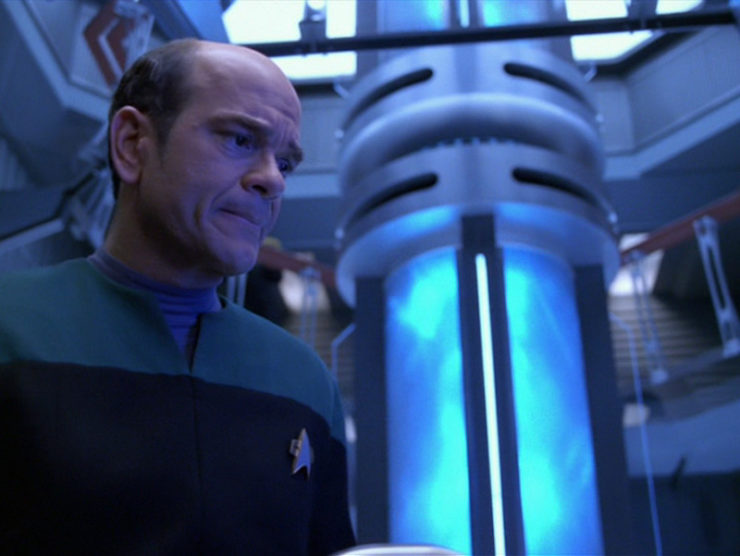“Warhead”
Written by Brannon Braga and Michael Taylor & Kenneth Biller
Directed by John Kretchmer
Season 5, Episode 25
Production episode 219
Original air date: May 19, 1999
Stardate: unknown
Captain’s log. For the fourth night in a row, Kim is in charge of gamma shift. He and the conn officer, Ensign Jenkins, banter for a bit on the subject of how seriously one should take the overnight shift, when they receive a distress call. Kim orders a course change toward the call to discover that the planet it comes from has no lifesigns.
Kim wakes Chakotay, who assures him that he did the right thing, and then offers to let Kim lead the away team. An eager Kim beams down with a security guard, Lang, and the EMH. They discover no life, but they do find a device that communicates in a language that the EMH’s translator matrix can translate, but the universal translators in everyone else’s combadges can’t for reasons the script never bothers to explain.
The device is an AI, but it doesn’t seem to know who or what it is—or even that it’s a device rather than a person. The EMH talks to it, and he convinces Kim that they should beam it back to the ship to try to help it restore its memories. Kim then convinces Janeway and Chakotay to do so, beaming it into engineering with a level-ten containment field.
One thing the device remembers is that it had a companion. Janeway and Seven scan for this companion in astrometrics while Torres, Kim, and the EMH try to restore the device’s memory. After determining that it’s safe, they transfer the device to sickbay with the object of trying to create a holographic matrix to put the AI in.
Janeway and Seven find the companion, or, more accurately, its impact: it crashed into the surface and exploded.
It soon becomes clear that these two devices are weapons of mass destruction. Janeway calls a meeting to discuss what is to be done with it. The device doesn’t remember its function, and it’s a sentient being. The EMH pleads for the AI to be extracted from the weapon as planned. Janeway agrees, however when they try to implement this plan, the AI realizes what they’re doing and interprets it as an attack, arming itself. The EMH tries to convince it to disarm, but it’s having none of it, so Janeway orders Torres to shut it down with an EMP.
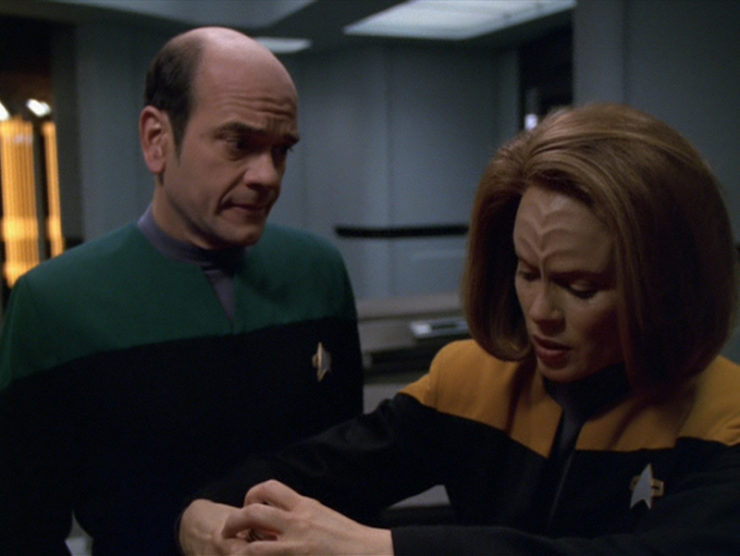
That works, but the AI transferred itself out of the warhead and into the EMH’s mobile emitter before the EMP hit it. Now it has taken over the doctor’s ambulatory form and sealed off sickbay, trapping Torres and Kim in there with it, and keeping everyone else out.
The AI has its memories back, at last: it’s a warhead created by the Druoda for their war against the Salinians. Its mission is to attack a military installation on Salina Prime and destroy it. It intends to fulfill that mission, and instructs Janeway to set course for Salina Prime. If she doesn’t, it will arm itself and destroy the ship.
Buy the Book
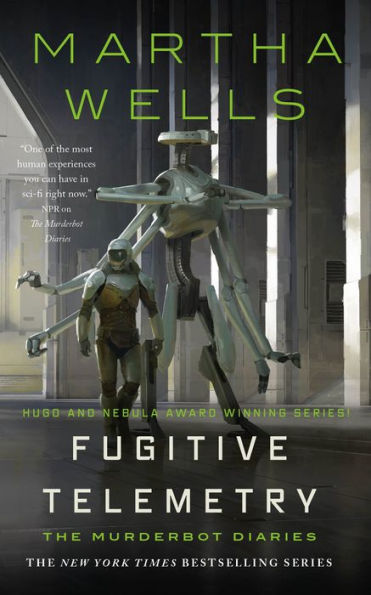

Fugitive Telemetry
Neelix recently obtained a power node from a trader named Oquanii, and the node has a similar configuration to the warhead. They track Oquanii down, and he recognizes the warhead and offers a method of disabling it and taking it off their hands. However, Janeway insists that the weaponry portions of the device not be given to Oquanii. The trader insists on all or nothing, though he does promise not to sell it as a weapon, but rather to break it down into bits and sell the bits, which can be used for other things. Janeway, however, can’t really trust the word of a trader she just met and sends him on his way.
That lack of trust proves wise, as Oquanii immediately fires on Voyager. He tries to punch a transporter beam through the shields to beam the warhead out, but the AI detects that, sends an antimatter surge through the transporter beam, which blows up Oquanii’s ship.
A fleet of three dozen or so warheads of similar design are flying through space. They detect Voyager and head toward it.
The AI demands that Kim and Torres reconstruct some of his memory, as there are still gaps. They do so, and discover that this warhead, its companion, and many others were launched accidentally. The war between the Druoda and the Salinians was over three years ago. They sent a command to disengage, but about thirty-three of them didn’t get the message, apparently. The AI is skeptical, thinking that it’s either Salinian sabotage or Kim and Torres creating false data to save their own lives. The AI also doesn’t see a command authorization code, but Kim points out that it could be in the parts of the warhead’s memory they haven’t reconstructed yet.
Plan B is to use Seven’s nanoprobes to disable the warhead. However, that requires Seven being physically in sickbay. So Janeway has Paris fake going through one of the nearby minefields, with false sensor readings sent to sickbay indicating damage. Seven will be “injured” with plasma burns, and have to be brought to sickbay for treatment. Tuvok will then disrupt the holographic matrix, which won’t last long, but will give Seven enough time to disable the warhead.
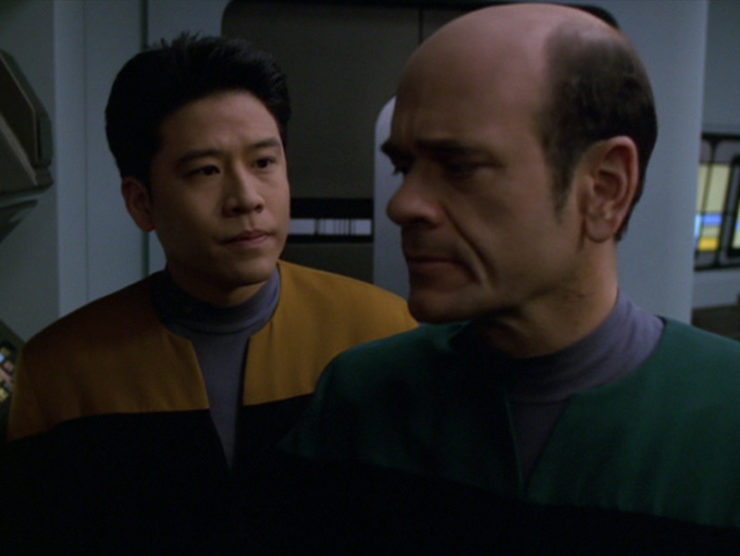
The plan almost works, but the warhead has defenses against attacks like Seven’s, and a feedback loop renders her unconscious. So they go to Plan C, which is Kim pleading for compassion. The AI rejects that notion at first, but Kim points out that it was the EMH’s compassion for it that led to its being brought on board Voyager and getting its memories back. Its mission is to protect people, but all fulfilling this particular mission will do is kill people for no reason.
By the time the AI is convinced by Kim’s pleading, the other thirty-two warheads have caught up to Voyager. Unfortunately, they’re now within two light-years of their target, and the warheads can’t accept any change to their program this close to the target (which is, at once, completely idiotic and completely realistic). The AI realizes that the only way to stop those warheads from destroying the installation on Salina Prime is to be beamed out into space and then detonate, taking the other warheads with it.
Kim expresses sorrow, but the AI says again that its job is to protect people—it’s just the target that’s changed.
After the warheads are all destroyed, we see Kim starting the night shift. Jenkins says thanks, on behalf of the junior staff (of which Kim is one, but never mind). Kim’s reply is to request that there be no distress calls, please.
Can’t we just reverse the polarity? The Durodans have built their warheads with an artificial intelligence for reasons that are never made entirely clear, since they’re pretty much preprogrammed missiles. Then again, this one is explicitly flawed in some way, as it didn’t take to the recall command, so maybe the ones that work right are more versatile.
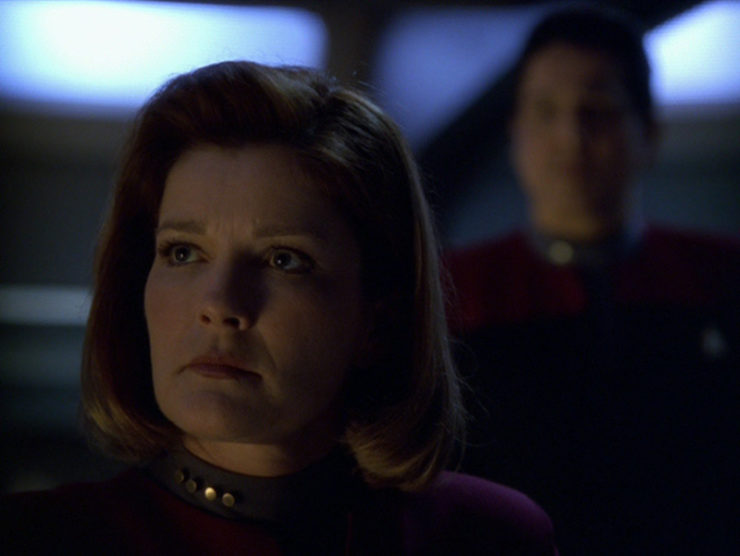
There’s coffee in that nebula! After the attempt to sabotage the warhead fails, the AI instructs Janeway to abandon ship. She refuses. The AI points out that it will destroy the ship, and Janeway very calmly tells him to go ahead. When the AI counters that everyone on the ship will die, Janeway, still very calm, says that yes, but nobody else will. It’s quite the captainly moment.
Forever an ensign. It makes no sense, none, that Kim is still an ensign after five years, yet is still considered “senior staff” and gets to be in charge of the bridge during gamma shift. As a low-ranking officer, he’s as much “junior staff” as Jenkins, and while Jenkins should still be calling him “sir” when he’s watch officer, there’s still not that much of a gap between the two of them in terms of their place on the ship.
The issue here, for the record, isn’t that Kim is in charge of gamma shift, or considered senior staff, it’s that he is still at the same rank he was at five years ago…
Half and half. Torres evinces no interest in engaging the AI in conversation, and does nothing to aid Kim in his attempts to convince the AI that he’s being a big stinky. To be fair, that sort of thing isn’t really in her wheelhouse…
Everybody comes to Neelix’s. Apparently Neelix is skilled enough in makeup to create convincing-looking plasma burns on Seven’s face. Paris jokes that, if he keeps this up, Janeway will promote him to Senior Beautician. (And maybe he will get that title, but he’ll never be the best person to hold that position….)
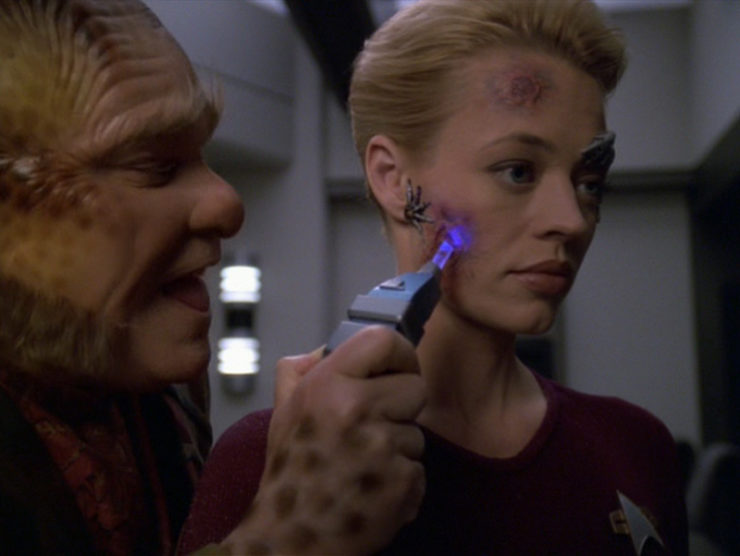
Please state the nature of the medical emergency. The EMH advocates mightily for treating the AI with respect and compassion, and gets his body taken over for his trouble.
Resistance is futile. It has, at this point, become a cliché that Seven’s nanoprobes keep being the go-to solution for an episode’s problems, so it’s nice to see that it doesn’t actually work here.
No sex, please, we’re Starfleet. Paris totally forgot that it was the anniversary of his and Torres’s first date, and the episode opens with him negotiating with Neelix for a trade of replicator rations to put together a great date night. Of course, Torres spends the evening stuck in sickbay with Kim and a crazed AI…
Do it.
“Helm, status?”
“Same as it was twenty minutes ago.”
“Refresh my memory.”
“Current speed warp 6.3, heading 021 mark 2. Permission to speak freely, sir?”
“Granted.”
“We’re on the night shift—relax!”
“One of these days you’ll get the call to take the bridge, and maybe then you’ll understand the burden of command.”
–Banter between a pretentious Kim and an exasperated Jenkins.
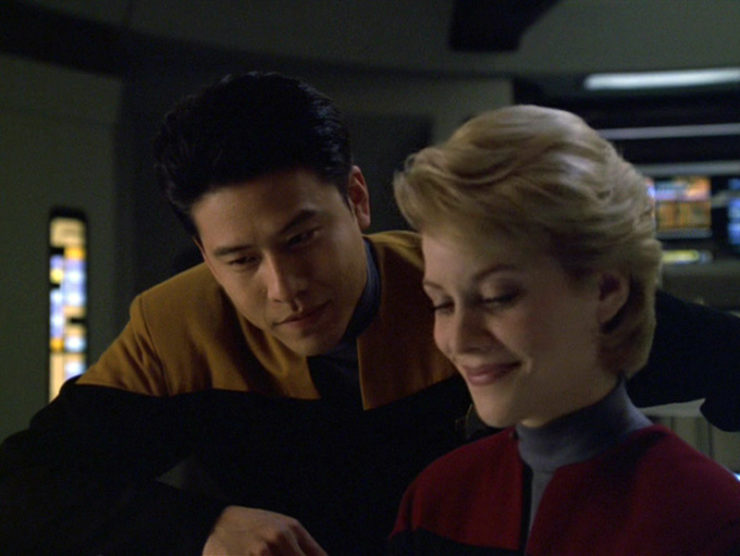
Welcome aboard. McKenzie Westmore plays Jenkins. She previously played one of the little girls in TNG’s “When the Bough Breaks,” and will later play a background alien in Picard’s “Maps and Legends.”
Steve Dennis plays Onquanii, his third of four appearances in this season of Voyager. He previously played one of the aliens in “Night” and Fennim in “Think Tank.” He’ll be back in the next two episodes (the “Equinox” two-parter) as Thompson (his only Trek role involving no makeup), and also play an Andorian in Enterprise’s “The Andorian Incident” and “Shadows of P’Jem.”
And regular extra Sylvester Foster gets a name for his character: Lang.
Trivial matters: This episode was inspired by Brannon Braga watching an episode of Frontline about the huge stockpile of nuclear warheads just laying around in the former Soviet Union that were, in essence, up for grabs.
The EMH’s built-in translation matrix was established in “Gravity.” The process of downloading the AI into a holographic matrix is similar to what was done with Denara Pel in “Lifesigns” and the re-creation of Crell Moset in “Nothing Human.”
McKenzie Westmore, who played Jenkins, is part of the Westmore family of Trek production folk, most of whom are involved in makeup and such: her father Michael, her brother Michael Jr., her uncle Monty, and her aunt June. Her great-aunt, Patricia Westmore, was the hair stylist on the original series. The character of Jenkins also appears in the alternate timeline of Places of Exile by regular commenter Christopher L. Bennett in Myriad Universes: Infinity’s Prism. She’s given the first name of Tricia, after the actor’s great-aunt.
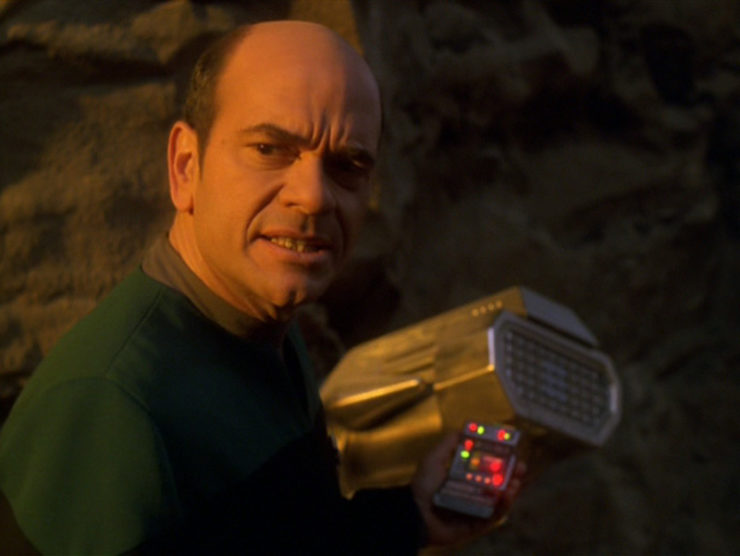
Set a course for home. “We’re going to find a way to outsmart a smart bomb.” In some ways, this is the same story as “Dreadnought,” except it’s Kim arguing with someone using the EMH’s voice instead of Torres arguing with someone using her own voice, but the episode works on its own for several reasons.
For starters, it’s a very Star Trek story, as it isn’t technobabble trickery or superior firepower that wins the day, but an argument for compassion and common sense over blindly following orders.
It’s fascinating that this story was inspired by a post-Cold War news story about all the excess warheads floating around Eastern Europe, because what this reminded me most of was two 1964 Cold War films. Fail Safe and Dr. Strangelove, or, How I Learned to Stop Worrying and Love the Bomb are two movies that are diametrically opposed in tone but have the exact same plot: something goes horribly wrong and American bombers are sent to attack the Soviet Union even though there’s no active state of war.
And that’s what happens here, too, with the main change being that the catastrophe is averted. Where the 1964 movies are about the tyranny of preprogrammed instructions, the AI in the warhead is able to think through the problem, goosed by an impressively eloquent Harry Kim, and then perform a noble act of self-sacrifice for the greater good. Which is what it was programmed to do in the first place, of course—as the AI itself says, it’s just got a different target for the same mission.
Both Robert Picardo and Garrett Wang shine here. Kim’s pretentious goofiness as he struts across the bridge all large and in charge is ridiculous, but it serves as a nice prelude to a proper command situation. And unlike so many other mediocre attempts to show how Kim has matured that the show has stumbled through over the years with varying levels of success (“Emanations,” “Non Sequitur,” “The Thaw,” “The Chute,” “Alter Ego,” “Favorite Son,” “Demon,” “Timeless,” “The Disease”), this one actually feels earned and legitimate. And it truly builds on Kim’s previous experiences as a bridge officer on a starship for five years, showing what he’s learned.
And man, Picardo is stupendous. I was worried that he’d devolve into stereotypical EEEEEEEEEEEEEEEEE-vil like he did in “Darkling,” but instead he gives us a hard, stubborn, determined, single-minded intelligence that refuses to deviate from what he’s been programmed to do. It’s an intense, impressive performance, latest in a series of bits of brilliance from Picardo.
Not to be outdone is Kate Mulgrew’s quiet confidence as she tells the AI to go jump in a lake. She plays along with the AI’s instructions at first to keep her crew safe, but as time starts to run out, she makes it abundantly clear that she’ll sacrifice the ship and crew to keep them from being used as a weapon of war against their will.
Warp factor rating: 9
Keith R.A. DeCandido is also reviewing each new episode of The Falcon and the Winter Soldier as they’re released on this site.










